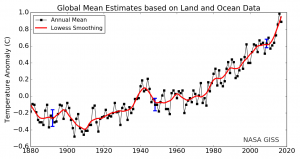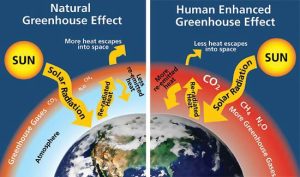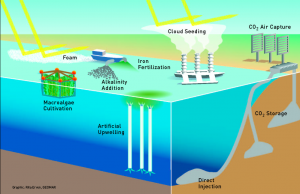Are you scared about what’s happening to our planet? Global warming is more of a problem than it has ever been before. The last five years have been the warmest in recorded history with 2018 ranked the fourth hottest. There have been numerous articles detailing the whole 12 years we have left on this planet and sea levels are rising at their fastest rate in the past 2000 years. The future is not looking so hot…

Land-ocean temperature index, 1880 to the present. Source: NasaAt what point do we recognize that climate change is spiralling out of control? There was promise when 195 nations signed the Paris agreement endeavouring to cut carbon emissions. However, this collective action may not be enough with the USA, the world’s second largest greenhouse gas emitter, threatening to withdraw. In the meantime, scientists are working to develop a solution to not only reduce the effects of global warming but also to hopefully reverse them too.
One potential solution is geoengineering – the deliberate large-scale intervention in the Earth’s systems to counteract climate change. While this sounds daunting, the solution is simpler than expected as it relies largely on the basic principles of the greenhouse effect. In case you need a little refresher, the greenhouse effect is a result of greenhouse gases in our atmosphere. These are naturally occurring gases such as carbon dioxide, methane, and even water vapour. Human activities such as farming and burning fossil fuels have significantly increased their abundance. As the sun shines visible light through our atmosphere, it sends solar radiation towards the Earth’s surface. Normally, a proportion of this solar radiation is emitted back towards space in the form of infrared radiation. However, the greenhouse gases block this path and reflect some of the infrared radiation back in all directions leading to further heating of our planet, and on a large scale, global warming.

Greenhouse Effect. Source: LiveScience
Geoengineering techniques can be largely divided into two main categories:
- Solar Radiation Management aims to reduce the amount of incoming solar radiation reaching Earth by reflecting it either in the upper atmosphere or near earth’s surface, helping to cool the planet.
- Greenhouse Gas Removal removes carbon dioxide and other prominent greenhouse gases from the air and oceans. This will hopefully reduce the greenhouse effect limiting how much more the temperatures rise.
The technology to achieve these goals varies greatly in complexity from painting all of our roads white (which is more reflective than black asphalt) to creating artificial clouds by spraying sulphur dioxide into the air with planes to further reflect solar radiation.

Different Geoengineering Methods Source: GESAMP
Scientists are making great strides into how we can begin to counteract the damage that we have already done but there still lies a lot of uncertainty in regards to the ethics, longevity, and sustainability of this solution. Is geoengineering a cheap short-term fix that is simply delaying the inevitable? This podcast discusses some of the potential issues with geoengineering as a global climate change solution.
